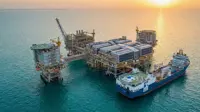Jakarta's small Su-30 order may have a much bigger follow-up
25 Aug 2007
Amidst the excitement of billion-dollar deals in high-tech military aircraft sales came a quiet announcement at the MAKS-2007 air show at the Zhukovsky air base near Moscow on 21 August, that Russian aircraft maker Sukhoi had entered into a memorandum of understanding with the Indonesian air force for the purchase of six Su-30 fighter jets - three Su-27 SKM and three Su-30MK2 - for $300 million.
Buying only six planes for $300 million is peanuts in the international arms trade.
It wasn't as though the Russians were keen on a first-time breakthrough with the country. The Indonesian air force already operates two Su-27SK single-seat and two Su-30MKK twin-seat fighters that it bought in 2003, for $192 million. Consequently, only the aviation media reported the deal.
But let us not underestimate the importance of the deal. More sales to Indonesia are probably in the offing. Industry sources say Jakarta wants to buy a full squadron of 16 Sukhoi fighters to replace its aging American F-16 jets.
Long-term international arms relationships often start small. A tiny sale, like the 2003 order for four Sukhois, has led to a slightly bigger order for six more planes now. Next, a full squadron of aircraft is likely to be on Indonesia's shopping list. The next sale after that may well make Sukhoi fighters Jakarta's prime interceptor aircraft, evicting US defence manufacturers who have dominated the Indonesian market for 40 years.
It's not the total size of the order, but the fact that it's a repeat order, which makes it significant. That is what indicates that the buyer was satisfied with what it got the last time, and now wants more.
The Russian government and the umbrella aircraft manufacturer United Aircraft Corporation (UAC), created last year by President Vladimir Putin to rationalise the Russian aircraft industry, clearly understand this. Selling a top-of-the-line interceptor like the Su-30 for only $50 million each, which is the price tag on the new order, is a bargain; it's almost like giving them away.
The Russian government is prepared to do even more. Indonesia is reportedly trying to negotiate a $1 billion loan from Russia to pay for the fighters and finance the possible acquisition of a Russian-made Project 636 kilo-class diesel submarine. Subsidising other countries to buy weapons systems is a long-established and widely accepted tactic of arms manufacturing countries. The United States has been doing it for years.
It brings the buyer nation closer to the arms exporting country, and is an indirect subsidy for domestic defence manufacturers. Often, it helps keep ailing units going, lowering unit costs for the manufacturer nation's own armed forces, apart from saving jobs. Besides, with its treasury overflowing with oil and gas revenues, the Kremlin can easily afford the sums involved.






















